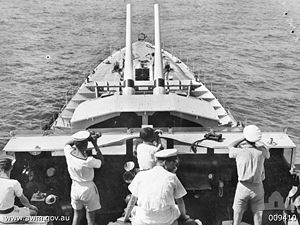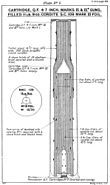| QF 4.7 inch Mark IX | |
|---|---|
 Single Mk IX gun on HMCS Assiniboine with gunners sheltering behind the shield | |
| Type | Naval gun |
| Place of origin | United Kingdom |
| Service history | |
| In service | 1928-1970? |
| Used by |
Royal Navy Royal Canadian Navy Royal Australian Navy Royal Hellenic Navy Royal Netherlands Navy Polish Navy Royal Norwegian Navy Turkish Navy Dominican Navy Argentine Navy Brazilian Navy |
| Wars |
World War II Korean War |
| Production history | |
| No. built | 742 (Mk IX); 372 (Mk XII) |
| Specifications | |
| Mass |
2.963–2.984 long tons (3,011–3,032 kg) (Mk IX) 3.238–3.245 long tons (3,290–3,297 kg) (Mk XII) |
| Length |
220.62 in (5.60 m) (Mk IX) 224.08 in (5.69 m) (Mk XII) |
| Barrel length | Bore: 212.58 in (5.40 m) L/45 (cal) |
|
| |
| Shell | Separate-loading |
| Shell weight | 50 pounds (22.7 kg) SAP or HE |
| Calibre | 4.7 inches (120 mm) |
| Breech | Semi-automatic horizontal sliding-block |
| Recoil | Hydro-pneumatic |
| Elevation | Varied by mounting |
| Rate of fire | about 12 rounds per minute |
| Muzzle velocity | 2,650 ft/s (810 m/s) |
| Maximum firing range | 16,970 yards (15,520 m) at 40° |
The 4.7 inch QF Mark IX and Mark XII[1] were 120-mm 45-calibre naval guns which armed the majority of Royal Navy and Commonwealth destroyers in World War II,[2] and were exported to many countries after World War II as the destroyers they were mounted on were sold off.
Description and history[]
These guns succeeded the similar World War I-era BL 4.7 inch gun, changing the cartridges from BL silk bags to separate QF in brass cases and a new horizontal sliding block breech mechanism.
Mark IX was deployed in single mountings CP Mk XIV on the A class destroyers of 1930 and on most subsequent destroyer classes up to and including the R class of 1942.

The almost-identical Mk XII gun was deployed in twin mountings CP Mk XIX on the Tribal class destroyers of 1936 and J, K and N classes of 1938. This mounting limited the maximum elevation to 40 degrees, but all twin CP Mk XIX were dual-purpose mountings and were equipped with Fuze Setting Pedestals or Mk V Fuze Setting Trays,[3] to allow the mountings to be fired against aircraft while being controlled by the Fuze Keeping Clock fire control computer. Typical maximum rate of fire was twelve rounds per gun, per minute.[4][5] During gunnery trials in 1930, HMS Basilisk'' was able to fire "...five rounds in 17 seconds."[6] The Mk XII gun fired a 50 lb shell and used a separate cartridge, with both shell and cartridge being loaded via a loading tray, with power ramming, elevation, and traverse. The maximum range at 40 degrees elevation was 16,970 yards (15520m) fired at the new gun muzzle velocity of 2650fps (808 m/s).[2] The 40 degree elevation was justified on the grounds that destroyers would be screening the battle-fleet during aerial attack, and 40 degrees elevation was adequate to engage aircraft that were concentrating their attack on other ships.[7]
Admiral Sir Philip Vian describes the use of Tribal Class destroyer mounted Mk XII guns against aircraft during the campaign in Norwegian waters, April through June 1940:
"It became clear at once that in an attack from the air in narrow waters flanked by mountains, the cards were held by the aircraft. There was too little sea-room for full freedom of manoeuvre, and the aircraft's approach was screened by the rock walls. As often as not, when they did come into view it was at such an angle that our 4.7-inch guns, whose maximum elevation was only forty degrees, could not reach them... Aandalsnes is approached through the Romsdal Fiord, and lies forty miles from the entrance, off which we arrived on the 24th April. The daylight passage of the convoy and escort through this waterway, speed five knots, on a steady course and with mountains rising steeply either side, presented an alluring invitation to enemy aircraft. Junkers attacks persisted to the end, but the fire of the destroyers, although limited to an elevation of forty degrees, was enough to keep the enemy just too high for their standard of marksmanship. Not a ship received a direct hit, though some were damaged by the splinters from near misses."[8]
The S class, introduced the CP (central pivot) single Mark XXII mounting for the QF Mark XII 4.7 in gun. This new mounting had a shield with a sharply raked front, to allow increased elevation (to 55 degrees),[9][10] contrasting noticeably with the vertical front of the previous CP Mark XVIII, and easily differentiated the S class onwards from their immediate predecessors. The Savage was the exception in this respect, being fitted with 4.5 inch calibre; a twin mounting forward and two singles aft.
The 4.7 inch calibre was finally superseded by the 4.5 inch calibre on the Z class destroyers in 1943. The new 4.5 inch guns all had 55 degree elevation mounts and actually fired a shell slightly heavier than that of 4.7-inch Mk IX and XII guns, although slightly lighter than that fired by the 4.7 inch Mk XI gun.
Ammunition[]
Weapons of comparable role, performance and era[]
- 12.7 cm SK C/34 naval gun : equivalent German destroyer gun, firing slightly heavier shell
- 5"/38 caliber gun : approximate US equivalent, firing a slightly heavier shell
Notes[]
- ↑ Mark IX = Mark 9, Mark XII = Mark 12. Britain used Roman numerals to denote Marks (models) of ordnance until after World War II. This article covers the ninth and twelfth models of British QF 4.7 inch gun.
- ↑ 2.0 2.1 Campbell, Naval Weapons of World War Two, p48.
- ↑ Hodges and Friedman, Destroyer weapons of WW2, P95-96.
- ↑ Hodges and Friedman, Destroyer weapons of WW2, p21.
- ↑ March, British Destroyers, P358, Kimberly at Narvik: "Salvos fired about 180 in all...drill to guns very good, great part of the action a loading interval of about 5 seconds was achieved..."
- ↑ March, British Destroyers, P264
- ↑ Harding, editor, The Royal Navy, 1930-2000: innovation and defence, p19-41:, Pugh, Managing the aerial threat.
- ↑ Vian, Philip, Action This Day, London, 1960, p.40 and 44.
- ↑ March, British Destroyers, p.401.
- ↑ Hodges, Tribal Class Destroyers, p32: Diagram of High Level Bomber Attack: A 240mph target, at 12 thousand feet altitude could expect to be under fire for about 58 seconds, from the time it enters the effective range of the FKC until it flies to within the minimum range of a 4.7-inch gun elevated to 55 degrees. A Tribal class destroyer would be able to engage the same target for about 37 seconds with a 4.7-inch Mk XII gun elevated to 40 degrees.
References[]
- Campbell, John (1985). Naval Weapons of World War II. Annapolis, Maryland: Naval Institute Press. ISBN 0-87021-459-4.
- Hodges, Peter; Friedman, Norman (1979). Destroyer Weapons of World War 2. London: Conway Maritime Press. ISBN 0-87021-929-4.
- March, Edgar J. (1966). British Destroyers: A History of Development, 1892-1953; Drawn by Admiralty Permission From Official Records & Returns, Ships' Covers & Building Plans. London: Seeley Service. OCLC 164893555.
External links[]
| Wikimedia Commons has media related to QF 4.7 inch Mk IX Mk XII naval gun. |
- Illustration of a 4.7 inch single mount
- Tony DiGiulian, Britain 4.7"/45 (12 cm) QF Mark IX 4.7"/45 (12 cm) QF Mark XII
| ||||||||||||||||||||||||||||||||||||||
The original article can be found at 4.7 inch QF Mark IX & XII and the edit history here.


